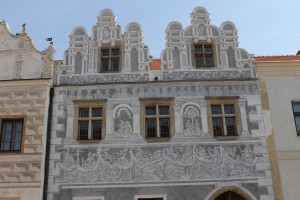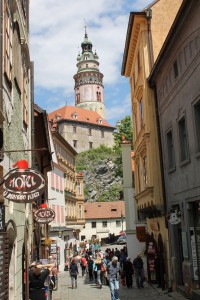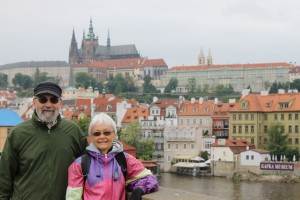Slavonice
Sunday, May 25th, 2014On to Slavonice. Our visit stopped in Ceske Budejovice to tour the Budweiser Budvar Brewery (no connection to the US Budweiser brand). The history of brewing here dates back to the 13th century and Budweiser Budvar was founded here in 1895. We saw the whole process from the artisan wells where the water is drawn, to the adding of malt, heating and cooling, adding hops and yeast, to bottling and packing. The mechanization was fascinating. Beer is considered Czech’s national drink; they drink 300 gallons/person/year, including children in the count. What we have observed makes this fact seem accurate! (Apparently, beer is high in vitamin B.)
We stopped in Trebon, an ancient walled village with fish “ponds” (small man-made lakes). Fish farming has been going on here since the middle ages. We had a fish lunch here; after we ate, we learned we had actually eaten eel! Jindrichuv Hradec is a 13th-century town where we visited the castle museum which features the world’s largest working mechanical Nativity scene. It was completed in 1756 by a burgher after 60 years of labor. There are 1398 human and animal figures, of which 133 are movable. The figurines are made of wood and laminate materials. It was very interesting, but unfortunately photos of the large Nativity were not allowed. We also visited the Gobelin tapestry museum. Two women were repairing a 300-year-old tapestry which will take them and others about 1 ½ years to complete.
We spent the next two nights in Slavonice, a small village of about 20,000. Our group filled the family-run hotel which also has an extensive wine cellar. During supper at a nearby restaurant, a music group of 4 men played traditional Moravian music as well as Irish, blues, U.S. folk, and more. It was great fun.
Slavonice’s peak history was the 14th-16th century. The town is known for its “sgraffito” exterior wall designs. Dark stucco is applied first, then white stucco over it. Designs are then scratched through the white layer.
We visited Mariz, a small arts village near Slavonice. In 1945, a 10 km-wide area along the borders with Austria, Germany, and Poland were “forbidden” areas and everyone was moved out. In the mid-60’s the area was again opened up but no one came until 1989. (For history buffs, there is fascinating history, but I’ll leave it for now.) Mariz ceramics are famous as each piece is original—no two are alike. We were given a chance to decorate our own mugs.
We explored the 13th-century ruins of Landstejn Fortress, climbing to the top where we were told we could see Austria 5 km away. We visited concrete bunkers built in 1935-38. They were meant to guard the Czech border against an invasion by Hitler but it didn’t help. In the Cold War, they were used to prevent Czech citizens from escaping to the West. We stopped to see part of the barbed wire fence built by the Russians to “keep the capitalists out.”
In the evening we were invited to a local home where we were shown how potato dumplings are made and were served a traditional meal of pork, sauerkraut, and dumplings. Our host also showed us around her herb and vegetable garden.
We were able to visit a small kindergarten in Slavonice and the village cemetery before departing for Bratislava.
- Budweiser Budvar logo
- Budweiser Budvar
- Budweiser Budvar
- Trebon fish pond
- Trebon castle
- “Fish” lunch
- Small Nativity scene
- Small Nativity scene
- Tapestry repair
- Tapestry explanation
- Weaving
- Our hotel in Slavonice
- Wine cellar
- Wine cellar
- Musicians
- Gate in Slavonice
- Stork nest
- Slavonice sgraffito
- Slavonice sgraffito
- Slavonice sgraffito
- Slavonice sgraffito
- Mariz ceramics
- Helping roll out clay
- Decorating our own mugs
- Decorating our own mugs
- Finished products
- Bunker
- Entering bunker
- Bunker locations near Slavonice
- Cold War fence
- Landstejn Fortress
- Landstejn Fortress
- Landstejn Fortress
- Landstejn Fortress
- Landstejn Fortress
- Home visit
- Making potato dumplings
- Home visit dinner
- Kindergarten visit
- Kindergarten visit
- Kindergarten visit
- Kindergarten visit
- Kindergarten visit
- Well-tended grave

































































































































